We occasionally link to goods offered by vendors to help the reader find relevant products. Some of these may be affiliate based, meaning we earn small commissions (at no additional cost to you) if items are purchased. Here is more about what we do.
For such a basic piece of equipment, choosing a frying pan can be a surprisingly challenging task.
With so many options available, it’s easy to slip into a bout of selection overwhelm. And when this happens, we’re likely to buy something, anything, just to make a decision!
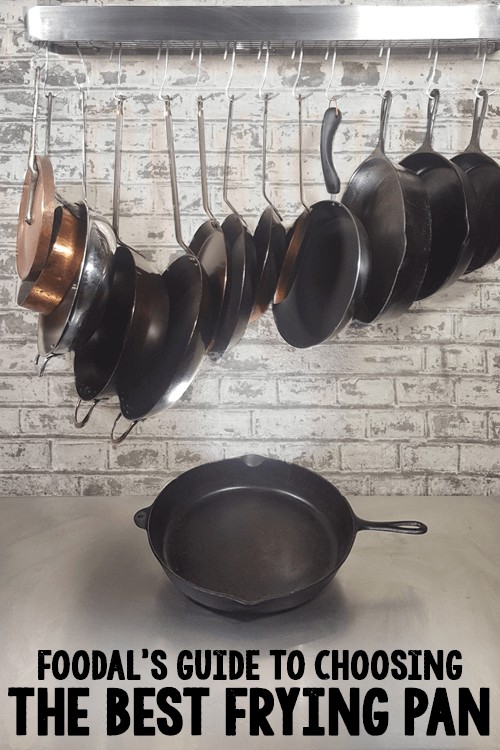
Unfortunately, this strategy often ends in disappointment. Food sticks, or burns, or won’t brown. They warp, chip, and peel. They’re too heavy, or not heavy enough… our complaints are as endless as there are varieties of pans.
Clearly, a little clarity will help us to make better choices!
Now, we just can’t say that one particular model is the “best” for everybody… unlike what some other websites attempt to do. That would be like saying, “These are the best socks for everybody.” Well, if I’m going to a dinner party, I dang sure don’t want to be wearing a pair of mountaineering socks with my formal wear.
The same holds true for frying pans and skillets. Different materials, cooking styles, and preferences mean different models are the “best” for a given individual, or may work better in certain circumstances. And even knowing the differences between a frying pan and a saute pan is also an area of consideration.
You may be more concerned with the ability to place the pan in the dishwasher rather than even heat distribution. Or perhaps you care more about removing unnecessary chemical coatings rather than finding an option with nonstick qualities. There are pluses and minuses, and benefits and trade-offs, that must be considered.
To that end, we’ve conducted a poll amongst Foodal staffers to find out their favorite models. We’ve also looked at some of the most common materials for frying pans and skillets – cast iron, carbon steel, stainless steel, copper, and nonstick coated options. We’ve outlined the qualities you can expect from each, and offer some buying tips as well, and then wrap up with a couple of recommendations for each category.
Frying Pan Material Comparison
| Cast Iron | Carbon Steel | Stainless (with Aluminum) | Copper | Nonstick Aluminum | |
|---|---|---|---|---|---|
| Weight | Heavy | Moderate | Learn More | Heavy (for the better products) | Light to Moderate |
| Heat Retention | Superb | Superb | Moderate | Poor | Moderate |
| Heat Transmission | Poor | Poor | Good | Superb | Good |
| Food Release (stickiness) | Good (when seasoned) | Good (when seasoned) | Poor (for the novice) | Poor to Good (depends on the liner) | Superb |
| Chemical Coatings | No | No | No | No | Yes |
| Induction Capable | Yes | Yes | Varies | No (with a few exceptions) | Varies |
| Dishwasher Safe | No | No | Usually | No | Usually |
| Price | Inexpensive | Inexpensive To Moderately Expensive | Moderate to Very Expensive | Very Expensive | Inexpensive To Very Expensive |
| Learn More | Learn More | Learn More | Learn More | Learn More | |
Now, let’s have a look at a few of the more popular cast iron, carbon, stainless steel, copper, and nonstick pans in today’s marketplace.
Best Cast Iron Skillets
One of the oldest of cooking materials, cast iron has many favorable qualities, and few drawbacks.
Slow to heat, iron has superb thermal properties. And once it reaches the temperature set point, it will retain a consistent heat for long periods.
With only a little care, cast iron will develop its own nonstick surface, or patina, from regular seasoning.
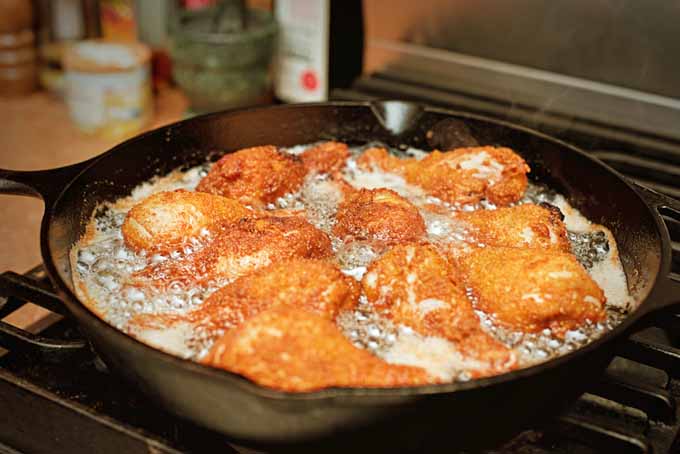
Seasoning cast iron, or curing, is the process of adding a small amount of oil to the surface, which creates a polymer bond with the iron. The cookware and oil are then heated to the oil’s smoke point, where carbonization takes place. And it’s these two processes that form the black carbon patina, with its wonderful nonstick properties.
To help consumers, a number of manufacturers today will pre-season their cast iron cookware at the factory. And while many users find this to be adequate, others will add another layer of seasoning before use. The more a pan is seasoned, the silkier the surface will become for releasing food.
Because of their weight, handles on iron pans are shorter than you’ll find with other materials. And they’ll be cast in one piece with the body, so handle security is never a problem.
A versatile material, it’s ideal for many cooking jobs such as baking, braising, broiling, frying, roasting, sautéing, searing, and stewing. Try using it to make our vanilla Dutch baby recipe.
With proteins, it will form a wonderful fond for reductions and sauces. It’s also a great metal for starting a one-pan dish on the stovetop, then transferring it to the oven for finishing.
Incredibly durable, a well-maintained piece of cast iron will last for decades. There are even cast iron aficionados who will scour garage and estate sales for vintage pans, looking for examples that are 50 or 100 years old, and which are still in serviceable condition.
Cleanup is achieved with a dry wipe using a paper towel, or rinsing with warm water and a sponge. For stubborn bits, use a copper scouring pad or stiff nylon brush with warm water. And using a bit of mild soap with warm water is okay as well, as a quick, soapy wash won’t penetrate a good patina.
Cast iron needs to be dried immediately, and if you’ve used water in cleaning, give it a light rub with cooking oil before storing. Never soak cast iron in water unless you intend to give it a full re-seasoning – it will rust.
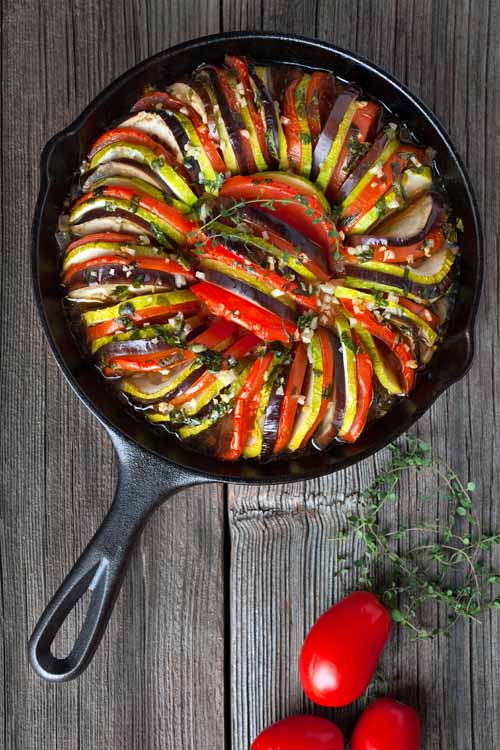
Cast iron is also inexpensive, making it a budget-friendly choice.
However, it doesn’t necessarily heat evenly, so hot spots can be an issue. And if it isn’t maintained with light oiling, rust will develop.
While it’s good on all stovetops, including induction, care needs to be taken on glass hobs, as sliding an iron pan around can scratch the surface. With glass, you should always lift your cookware to move it – and given the weight of cast iron (it’s heavy!), this can be a problem for some users.
Features to Consider
Helper Handles
With its dense weight, a helper handle on the opposite side is always a nice feature. That way, you can use two hands to lift it.
Pouring Spouts
Again, with this heavy material, lifting and pouring can be a chore. Look for a skillet that has dual pouring spouts to assist with maneuverability.
Pre-Seasoning
As mentioned above, many brands now offer cast iron skillets with a pre-seasoned feature, so it can be used right out of the box.
Enameled Interior Surface
A good option if you like the qualities of cast iron, but aren’t into the seasoning process. Porcelain has its own nonstick qualities, and a black matte porcelain finish is common for cast iron skillets.
The reason that skillets have a matte black enamel finish, as opposed to the more common glossy white enamel found on other pieces of cookware, is because the black enamel is fired at a higher temperature. This means it can withstand higher cooking temperatures for searing and browning – and it won’t show stains as readily.
Foodal has several informative articles on cast iron cookware, including this one on how to season cast iron. Or, just type in “cast iron” in the search box at the top of the page.
Lodge
If you like your skillets solid, heavy, and durable, these cast iron models from Lodge will fit the bill.
They are available in multiple sizes to outfit your kitchen with a complete set, or just grab the size that you want to round out your collection. I advise buying a 12-inch model for a large family, or the 10-inch model for an everyday pan to start, and then work your way up or down with additional sizes to meet your needs.

12-Inch Lodge Cast Iron Skillet
Virtually indestructible, these cast iron pans soaks up heat and distribute it evenly throughout the bottom and sidewalls, and they are unparalleled in heat retention.
All Lodge skillets come with a functional coating of oil baked into the surface for a light pre-seasoning that will be the foundation of your patina, for years of nonstick performance.
Lodge Pre-Seasoned 10.25-Inch Cast Iron Skillet with Red Silicone Hot Handle Holder
Also, the Lodge line of cast iron is very versatile, allowing you to go from stovetop to oven without a hitch.
And they handle high or low heat with ease. This makes them idealfor a variety of tasks including searing, sautéing, frying, grilling, braising, broiling, and slow cooking. And they are even suitable for use over a campfire.
They can also be used on all cooktops, including induction and glass – although care needs to be taken with glass or ceramic hobs, due to their weight.
The larger sizes have a short loop handle and helper handle to make transferring their weight easier. The red silicone handle holder can withstand temperatures of 400°F, and is easy to slip on and off.
And dual pouring spouts make it easier to transfer food from the pan to a serving dish.
A great alternative to chemically treated nonstick surfaces, cast iron does require a bit of maintenance – but you’ll be richly rewarded for your efforts with outstanding, easy-release performance.
Lodge 8-Inch Pre-Seasoned Cast Iron Skillet with Red Mini Silicone Hot Handle Holder
Lodge has been crafting cast iron cookware in the US for over a century, and enjoys a reputation of creating consistently reliable pieces for professional and home kitchens.
While this skillet does come pre-seasoned, you’ll get better performance with a light coating of cooking oil, which should be baked on, then cooled before using. Check out our complete instructions for seasoning cast iron if you’re unfamiliar with the process.
They are easy to care for with hand washing or a stiff nylon brush, and prompt towel drying is required. Before storing, a very light rub with cooking oil while the pan is still warm is recommended. Never soak any cast iron products or put them in the dishwasher.
These skillets are available in 8-inch, 10.25-inch, 12-inch, and 13.25-inch sizes. They are made in the USA in South Pittsburg, Tennessee.
While there’s no written warranty for Lodge cast iron cookware, they do stand behind their products and will address any product defects to the customer’s satisfaction.
What Others Are Saying
The following comments are taken from the most frequent remarks made by verified purchasers at Amazon.
From those who use and love cast iron, Lodge skillets get top marks for their high-quality build, easy-release properties, and outstanding durability.
They can be used and abused with metal utensils, roasted on a campfire (I’d recommend the massive 13.25-inch model for that chore), even put in the dishwasher, and still be restored to a reliable nonstick surface.
Lodge 13.25-Inch Cast-Iron Skillet
Of course, you should never put any raw cast iron cookware in the dishwasher, but just in case it happens, it’s nice to know that any rusty results can be reversed!
They heat up quickly on all stove tops, including induction, and hold a steady heat for a long time.
A great investment, once you learn how to use and maintain one of these wonderful pans, they’re virtually nonstick.
Although they come pre-seasoned, many reviewers suggest a light seasoning before using, to enhance the pan’s food-release qualities.
They need to be dried immediately after washing, and a light application of oil after cleaning will prevent rust and keep food from sticking.
A great price for a quality pan, it won’t warp or distort like other metals.
Treated well, this is cast iron at its best, and it cooks like a dream.
A common note is in reference to its weight: The specs say 8 pounds for the 12-inch model, so don’t expect to be flipping or tossing foods with this one.
The silicone handle is a nice bonus for most, although there are some complaints about it being a loose fit.
Compared to the accolades from those who love them, the number of complaints is small. And I believe the two main points of contention are due primarily to inexperience with cast iron.
The first quibble is that they rust after washing, and the second is that a slightly pebbled surface isn’t smooth enough to prevent sticking.
As many of the owners who responded to these comments pointed out, these issues would clear up with proper washing and drying techniques, and a light rub of vegetable oil after cleaning – or the occasional re-seasoning.
The pebbled surface will gradually disappear with use, as subsequent coats of oil and other foodstuffs polymerize into the surface.
Summary
There’s no doubt that these skillets are a favorite with the vast majority of owners.
But, being cast iron, they do require a bit of care – taking the time to clean, dry, and oil them after each use will bring out their best qualities. They are definitely not for those who think pre-seasoned means maintenance free.
And they are heavy, so they may not be the best choice for those with hand or wrist issues.
Having said that, Lodge produces good quality products, and these are no exception. Well-made, robust, and tough as (iron) nails, the larger sizes hold a large amount of food and have a wide variety of applications.
Bare bones in design, it would be hard to find better cast iron skillets in this price range.
Check prices and read all of the customer reviews on Amazon now.
Cuisinart Chef’s Classic Enameled Cast Iron Fry Pan
If you like your cast iron skillets to have a little flair, then this handsome enameled one from Cuisinart might be what you’re looking for.
With all the qualities typical of cast iron, the porcelain enamel coating has its own benefits.
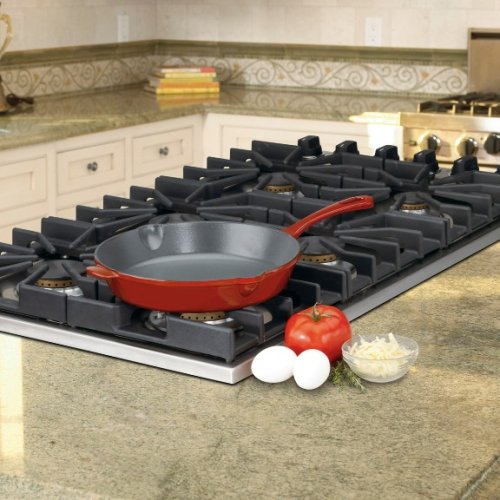
The enamel exterior provides a strong and durable finish and comes in two rich colors, Provencal Blue and Cardinal Red, making it an attractive addition to any kitchen. And the porcelain provides an extra layer of protection to prevent scratching on glass and ceramic hobs.
The black enamel interior is ideal for cooking, with its own nonstick properties. The surface imparts no flavor of its own, and it won’t absorb odors. It makes cleanup a breeze, and doesn’t require the regular seasoning needed with traditional cast iron.
The enamel requires very little oil for cooking, is safe for use with acidic ingredients, and also resists staining and general wear and tear.
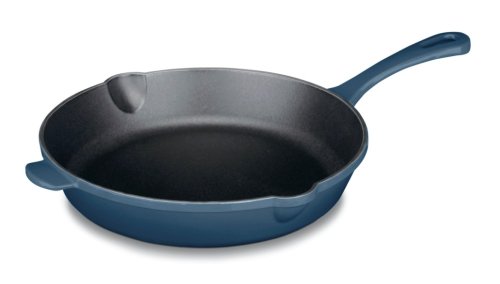
Cuisinart CI22-24BG Chef’s Classic Enameled Cast Iron 10-Inch Round Fry Pan, Provencal Blue
With excellent heat retention and even heating throughout the bottom and sidewalls, this versatile piece can go from stove to oven to table. Oven and broiler safe, it works on all stovetops, including induction.
The pan also features a large cast iron handle for a comfortable grip and easy maneuvering, a helper knob, and dual pouring spouts.
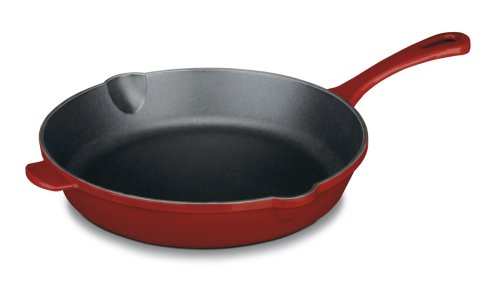
Cuisinart CI22-24CR Chef’s Classic Enameled Cast Iron 10-Inch Round Fry Pan, Cardinal Red
While most enameled cast iron will stick a bit at first, it will improve with use and perform better if the pan is not overheated. For best results with frying and sautéing, heat with a bit of oil to the proper temperature before adding food. And avoid rapid temperature changes to protect the enamel.
Lead and cadmium free, the enamel offers healthy cooking options, and makes cleanup easy with warm soapy water. Plus, the enamel even makes it dishwasher safe.
It measures approximately 17 x 11 x 4 inches, and weighs close to 6.5 pounds. This skillet comes with Cuisinart’s limited lifetime warranty, which excludes damage caused by overheating, abuse or misuse, accidents, or scratching and staining of surfaces. Made in China.
What Others Are Saying
The following notes are compiled from the most common comments from verified purchasers at Amazon.com.
A large majority of customers who purchased this skillet are very satisfied with its performance, and list its top qualities as being even heat distribution, easy food release, and simple cleanup.
A few common tips for the best nonstick performance are to avoid high heat, to heat with oil, and ensure that it’s adequately heated before adding food – and to be patient enough to let the food release on its own, which won’t happen if the pan gets too hot.
Another good tip is that regular cooking with acidic ingredients, such as tomato or wine-based sauces, is the best way to remove buildup and prevent staining.
And while it doesn’t need to be seasoned, a bit of oil rubbed into the interior surface after cleaning is something done on a regular basis by those who use it successfully.
With an attractive appearance, it’s also durable, sturdy, and well-enameled, which makes it suitable for glass-top stoves.
Washing with soap and water makes cleaning a breeze, and it can go in the dishwasher as well.
There are a couple of reported complaints from the naysayers, with the most common being that food sticks to the surface, and the other one being that the interior surface is too rough to be a truly nonstick surface.
Summary
The Cuisinart enameled cast iron frying pan gets high approval ratings from most of its users.
Like the Lodge skillet, I believe most of the complaints regarding food sticking are due in large part to inexperience with cast iron and enamel surface treatments. A little cooking oil rubbed onto the cooking surface before using would help considerably.
And while enamel does not have the same silky properties as Teflon, it does offer a safe alternative – especially if you give the pebbly matte finish a very light rub with oil after washing.
With an attractive splash of color on the exterior and a black matte enamel interior, it’s a reliable performer at a reasonable price.
Check prices and read customer reviews on Amazon.
Return to the Comparison Chart
Best Carbon Steel Frying Pans
Skillets made of carbon steel, aka black steel, have a few characteristics that are appealing to both the home cook and the professional.
Very popular with restaurant chefs, the carbon skillet is a versatile piece of cookware that may be used for everything from high-heat searing to more delicate tasks like creating egg dishes.
A carbon steel skillet forms its own nonstick patina with regular use and seasoning. This makes it a valuable tool for browning, as it makes frying eggs, pancakes (like our sweet cornmeal pancakes!), crepes, fish, and other fragile dishes easy and efficient.
With many similarities to its close cousin cast iron, carbon steel’s chemical signature has a little less carbon, which makes it much more flexible and less brittle. This means it can be formed with a thinner profile, resulting in a much lighter product with the same durable characteristics.
Some manufacturers refer to their carbon steel pans as iron because of their very high iron content (coming in at 99%), while others refer to them as black steel due to the patina that forms with use, and from exposure to heat.
Iron is number 26 in the periodic table of elements (Fe), and when impurities or slag are removed from iron ore, it becomes a steel alloy. Cast iron will have about 4% carbon, but when less than 2% carbon is present, it becomes a steel. And carbon steel will usually only have about 1% carbon to 99% iron.
But unlike cast iron, carbon steel pans are stamped from sheets for a very smooth surface that forms a sleek patina of polymerized oil in virtually no time.
Before use, wash and season as per the manufacturer’s instructions, and eggs will glide on its surface like skaters at the pond – often the first time you cook with it!
Continue to season carbon steel pans lightly after every use, until the interior surface is completely nonstick.
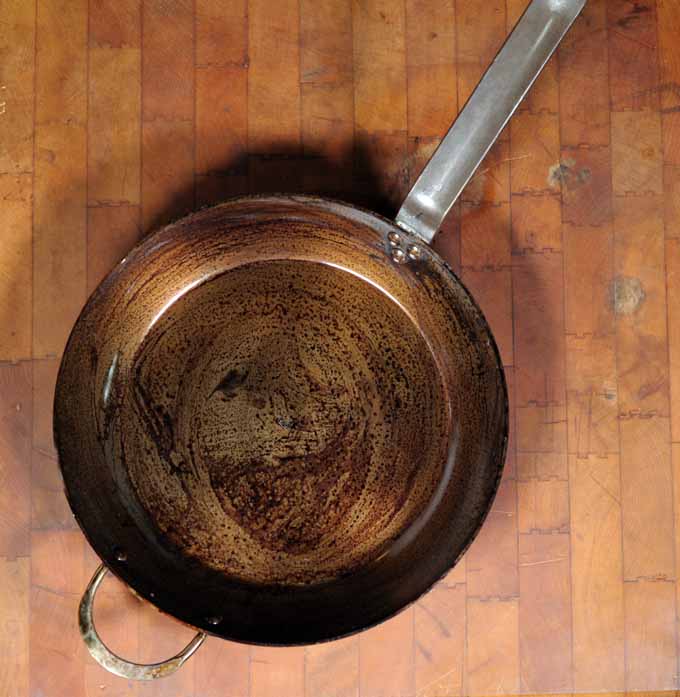
Naturally, with thinner steel, carbon pans heat up and respond to temperature changes quicker than cast iron, which gives them a bit more versatility.
However, carbon steel carries the same benefits (and drawbacks) as cast iron. Heat transmission, or the ability to heat up rapidly throughout the pan, is not nearly as good as what you’ll find with copper or aluminum (or a stainless and aluminum combo). But once it is hot, it retains its temperature range much better than its siblings.
This makes it particularly suited for high-heat searing and browning. Carbon steel is a natural for woks, crepe pans, and skillets – when food is added to the pan, it does not have a huge effect on the surface temperature. And that heat energy steadily transfers into the food as it is being cooked.
That being said, it is not well suited for more delicate sauteing and other cooking techniques when temperature control is absolutely critical. It doesn’t respond fast to changes at the burner or heat source. Copper followed by stainless multi-ply is better for those tasks.
This material is also safe for all stovetops, including induction. In fact, it particularly shines on induction ranges since it is very magnetic.
One of carbon steel’s drawbacks is that the untreated raw steel used will often react with both acidic and alkaline ingredients, and may result in a metallic taste in some foods.
A full patina will protect against any leaching of the metal when cooking with small amounts of these kinds of ingredients. But slow cooking highly acidic foods – like tomato sauce – can damage the nonstick veneer. This isn’t really a big deal in terms of the usefulness of the pan, as the patina can easily be repaired with regular use and light re-seasonings.
Be forewarned: carbon steel cookware should never go in the dishwasher or sit in water – if it does, you’ll have one big, rusty mess to clean up. This isn’t impossible, and rust doesn’t cause irreparable damage to a pan. But still, why go through that process if you don’t need to?
Always clean by hand. Usually, hot water with a wipe from paper towel will do. Then re-season lightly before storing.
Primary Features of Carbon Steel
Superb Searing and Browning Abilities
With many of the same qualities as cast iron, carbon steel can handle high heat when needed.
A Lighter Choice That Conducts Well
While it performs like cast iron, stamped carbon steel is much lighter and easier to handle. And it heats up more quickly, too.
Seriously Nonstick
Right from the factory, carbon steel quickly forms a nonstick patina that’s easy to maintain – and that’s a natural patina, not one made with synthetic coatings.
Safe for All Stovetops
Black steel can be used on induction ranges, and is light enough to use comfortably on glass hobs.
Save for Stove and Oven
These are oven safe too, so you can start a dish on the stovetop, then finish it in the oven.
Just to be clear, after some regular use, these pans will not look “pretty.” The steel in both the interior and exterior of the pan will change colors several times – eventually resulting in a dark, black patina on the inside, which is the nonstick coating. And color changes from heat transfer darken the exterior as well.
If cared for, these will take on the profile of well-used and appreciated tools – with all the scars of the trade. But assuredly, they will not remain factory polished and pretty, which is an important consideration for many.
Carbon steel certainly offers many outstanding characteristics, and is very versatile in the kitchen – but it won’t be a choice that’s suitable for every cook. You may want to also check out our complete carbon steel skillet guide for more information.
DeBuyer Mineral B Element Iron Fry Pan
The highly reputable French manufacturer DeBuyer has produced lines of cookware for the restaurant trade for decades, and more recently for the discerning home cook as well.
The Mineral B Element Iron fry pan is constructed of 99% pure iron and 1% carbon, and has a density of 3 millimeters, for a pan with outstanding heat reactivity and exceeding durability.
It arrives with a protective coating of 100% organic beeswax on all surfaces, to prevent oxidization and to assist with the seasoning process. Follow DeBuyer’s instructions for preparation and seasoning before use, or clean with very hot water and season with a fat or oil of your choice.
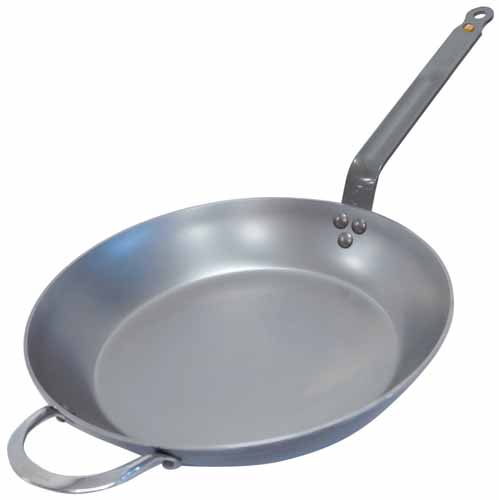
DeBuyer Mineral B Element Iron Frypan, 12.6-Inch Round
The Mineral B easily reaches high temperatures to quickly seal in juices, nutrients, and flavor, and is ideal for searing, browning, or grilling. But it’s also equally adept at cooking more delicate items like eggs and fish, thanks to the development of a natural nonstick patina – which quickly forms with just a bit of use and regular seasoning.
As with all high-iron cookware, the more the pan is used, the better it cooks. Or, as DeBuyer puts it, “The blacker it gets, the less it sticks.” And this is achieved with a completely natural process – no synthetic coatings are used.
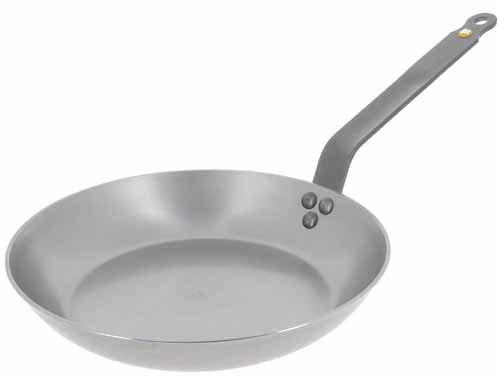
DeBuyer 10.2-Inch Mineral B Element Iron Frypan
With a traditional French Lyonnais design, the curved skirt of the pan makes for quick release of all foods, and ingredients slide easily from the pan to a serving dish. The long handle is securely triple riveted to the skirt, to provide a safe and secure grip.
Made in France, it comes with DeBuyer’s lifetime warranty against manufacturing defects. And they are available in variety of sizes including 7.9-inch, 10.2-inch, 12.6-inch, and 14.2-inch options.
Again, remember never to leave an iron pan in standing water or put it in the dishwasher. Hand wash only with very hot water, wipe dry with paper towels, and re-season lightly before storing.
What Others Are Saying
The following notes are compiled from the most frequent reviews from verified purchasers at Amazon.
The DeBuyer Mineral B gets top marks from happy shoppers for its outstanding cooking performance, high-quality construction materials, and artisanal craftsmanship.
It shows particular brilliance in the areas of fast and high heat conductivity, and beautifully seals, sears, and browns proteins like steak, scallops, crab cakes, and cuts of fish. And deglazing a fond is easy as well, producing lovely, rich reductions.
The pan comes with a pre-seasoning that most feel is effective in its nonstick properties, even when handling finicky eggs. And all are in agreement that the more this pan is used and tended to with a bit of oil, the better its food release qualities – with a handful comparing it to the release of a Teflon coating.
A good majority of reviewers remark that both cleaning and seasoning are easy and quick. They either followed DeBuyer’s directions before using, or used their own seasoning regime to develop a patina. And washing up is completed with just hot water and paper towels, plus a drop of fresh oil afterwards.
Even heat distribution is another top quality with the Mineral B, with a number of owners saying it is equal to or better than tri-ply.
Most reviewers rank the weight of their carbon steel as being lighter than cast iron, but a bit heavier than stainless – and they say that the weight of a large diameter pan can be a bit overwhelming for those with a slight build, or any kind of weakness in the hands or wrists.
A lot of reviewers also comment on the professional hands-on build and high-quality materials used, likening it to the feel of a well-constructed tool. The materials are uniform in thickness and consistent in density, solidly made of durable goods, with top-notch finishing details – this is a reliable piece of cookware that delivers as it should.
And it doesn’t warp, even when subjected to intense and aggressive heating. Overall, this is an easy to care for, worry-free pan.
On the downside, the DeBuyer comes with an epoxy coating on the handle, which means it can only “flash” in the oven, for 10 minutes maximum at a top temperature of 400°F. Anything longer or higher than that, and it will melt.
Perhaps surprisingly, some have done this intentionally. A couple of reviewers report they’ve removed the silicone logo, then put the pan through a self-cleaning oven cycle to reduce the coating to ash.
The most common complaint is that the pan isn’t nonstick, or that the required effort to achieve a slippery surface is too fussy, too hard, too inconsistent, or too much work.
Summary
The DeBuyer Mineral B Element Iron Fry Pan is a lovely tool with a boutique cachet – and its artisanal qualities really come to light when the cook is able to enjoy facilitating the pan’s development as a high-quality cooking implement.
Its ability to handle high temperatures with quick thermal reactivity makes it one of the best for searing and browning proteins. It won’t warp, even with aggressive heating. And with a little care and attention, it will develop a wonderful nonstick patina.
DeBuyer 14.2-Inch Mineral B Element Iron Frypan
But, it won’t be suitable for those who find seasoning a challenge, or who prefer a pan with a shiny, clean appearance.
A lifetime investment when taken care of, the DeBuyer Mineral B Element Iron Fry Pan proves to be well worth the price. This is an excellent choice in the carbon steel category.
Check prices and read customer reviews on Amazon now.
Lodge Carbon Steel Skillet
Lodge, the iconic American maker of quality cast iron products, has recently forayed into the realm of carbon steel – and brings us their line of heavy-gauge fry pans.
Pre-seasoned at the factory for a natural, easy-release finish, the nonstick qualities will improve with use and a light rubbing of vegetable oil after each wash-up.
The heavy-gauge carbon steel measures in at a thickness of 2.75 millimeters for a robust and sturdy density, yet it has the smooth surface of stamped steel that makes it ideal for developing a patina (although it’s not quite as smooth as the DeBuyer offerings – the Lodge has a very slight pebbly finish).

Lodge CRS12 Carbon Steel Skillet, Seasoned and Ready to Use, 12-Inch
Theses skillets can also take the high heat needed to accomplish all browning and searing tasks, with even heating and nimble thermal reactivity.
The design of the Lodge is similar to that of a French fry pan, with high, curved walls for easy movement of foods. And it has a long steel handle that’s securely held in place with three steel rivets through the pan’s skirt.

Lodge CRS10 10-Inch Pre-Seasoned Carbon Steel Skillet
Like all carbon steel pans, these Lodge models will need to be hand washed with hot water only, and dried with paper towels. Re-season lightly with a little oil after each wash, to maintain and develop its food-release properties.
These are safe for use on all stovetops, including induction.
Lodge carbon steel pans are available in 8-inch, 10-inch, and 12-inch sizes.
The Lodge 12-inch measures approximately 20 x 12 x 1.5 inches and weighs 4 pounds. Made in the USA, it comes with Lodge’s lifetime guarantee against manufacturing defects.
What Others Are Saying
The following comments are taken from the most frequent remarks from verified purchasers on Amazon.
The Lodge Carbon Steel line gets good marks for its reliable construction, easy care characteristics, and the quick development of a nonstick patina.
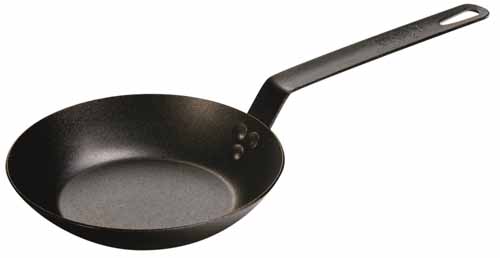
Lodge CRS8 Pre-Seasoned Carbon Steel Skillet, 8-Inch
Happy shoppers report that these pans replicate most of the advantages of cooking with cast iron, but without the weight. The factory pre-seasoning gives it a good easy-release initial coating, and a full nonstick surface is quickly developed with just a bit of care and attention.
It has a lighter touch than cast iron, but still provides a durable feel with even heating, and it is also very responsive to temperature changes.
Easy to care for, metal utensils and spatulas won’t harm the surface. And it can go from the stovetop to the oven as well.
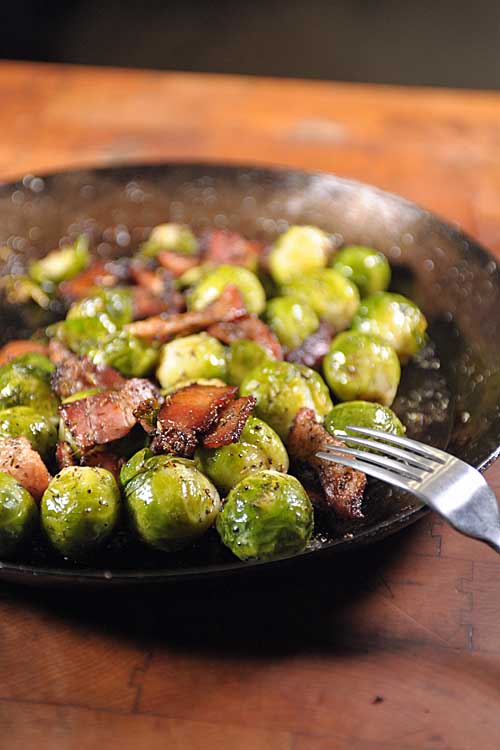
On the complaints side, there are a couple of common themes:
The biggest cosmetic concern is that the external layer of seasoning has a tendency to flake and peel off. And while this doesn’t actually affect the pan’s performance, it does raise the anxiety level for a number of owners who see this as problematic.
A more worrisome issue is addressed in a handful of complaints about the pan warping when exposed to high heat. This is not catastrophic if you have a gas stove, but definitely a problem with glass and induction hobs that require full contact with a flat surface.
Summary
The Lodge line of carbon steel skillets has many of the qualities we’ve come to expect from the brand – sturdy construction, good materials, and a reasonable price.
However, in the area of reliable performance, some issues are raised. The inconsistency in its ability to take high heat shows up in unwanted warping, and negates its browning and searing abilities for many users – particularly those with induction or glass stovetops.
And a flaking outer layer of seasoning is also an issue with some purchasers. As mentioned, this doesn’t alter the performance, but to some folks it makes the pan look defective (at least until an additional layer of seasoning has built up).
Nonetheless, since it is available affordably, it might be worthwhile to take a risk on the Lodge. And if it does warp, Lodge is known to stand behind their products with easy exchanges related to manufacturing defects.
Check prices and read customer reviews on Amazon now.
Return to the Comparison Chart
Best Stainless Steel Multi-Ply Frying Pans
Bright, shiny, and easy to clean, stainless steel is the material of choice for many home cooks and professional chefs alike.
On its own, steel does not conduct heat well – aluminum and copper are much better conductors. To enhance the qualities of stainless steel, skillets of decent quality will be clad using a couple of methods. They’ll either have a full-sized disc bottom with an aluminum or copper core between two layers of stainless, or the body itself will have an inner core.
This cladding is often referred to as tri-ply, five-ply, or even seven-ply, depending on the number of layers used in construction. Generally, the more layers a pan has, the more evenly it heats.
Partial cladding encompasses the bottom and the lower portion of the sidewalls, while full cladding will extend from the bottom all the way up to the rim. This offers the advantage of even heating throughout the walls, not just on the bottom – an important point, as walls that are thinner than the bottom are more likely to burn ingredients.
Of equal importance is the quality of stainless steel used. A good grade for pots and pans is 18/10, similar to that of cutlery. The 18 stands for the percentage of chromium, which provides corrosion and rust resistance. And the 10 stands for the percentage of nickel, which also provides some rust resistance, and gives steel its shiny, silver appearance.
Much lighter than cast iron, you should be able to lift a stainless steel model with just one hand. And due to their lighter nature, the stick handle will usually be a bit longer than the ones found on iron skillets – which gives them greater maneuverability for tossing, flipping, shaking, and pouring.
Good on all stovetops, it also does a yeoman’s job for most cooking tasks. Braising, deglazing, frying, sautéing, searing, and stewing are all suitable for stainless steel skillets.
If you’re going to have have one pan for multi-use cooking, a multi-clad stainless model would be the best choice. The larger sizes are excellent for making one-pan meals.
But not all are built for going in the oven or under a broiler, as oxidization may occur, and the handle material might not hold up to high heats (particularly if it’s made of plastic).
Stainless steel is also easy to clean. Warm, soapy water and a sponge with a rough side will take care of most tasks, while a stainless steel cleaner will handle tougher chores. And light stains from cooking starches, like pasta or rice, can be cleaned with white vinegar or lemon juice.
But, stainless steel can, and will, oxidize when exposed to temperatures above 500°F for longer than 10 minutes – and this oxidization, seen as an amber stain, will not come off. While harmless, it can ruin the appearance.
Also, stainless steel is not a nonstick material. A fat or oil is needed to form a barrier between the steel and food for most frying tasks.
Points to Ponder When Purchasing
Disc Bottom or Cladding
Cladding has the advantage of full heat distribution over disc bottoms, but both are superior to stand-alone stainless steel.
High Quality
Look for grades with chromium and nickel ratios of at least 18/8 or 18/10 for the best stain and corrosion resistance.
Handles
If made of stainless steel, a hollow cast, stay-cool handle is a nice feature. Silicone and plastic are common handle materials, but many aren’t suitable for use in the oven.
Rivets
Check to see how the handle is attached. Rivets are a sturdier option than screws or bolts.
Weight
If your cooking practices include tossing or flipping ingredients, ensure the weight will be suitable. And remember that if you’re looking at clad pans, the more cladding involved, the heavier it will be.
Demeyere 5-Star Proline
Demeyere was founded as a family company in the early 1900s in a small town in Belgium, and now specializes in the manufacture of top-end stainless steel cookware under the Zwilling J.A. Henckels brand.
An industry standard for the production of stainless steel cookware, Demeyere pieces are employed by professional and amateur chefs worldwide, as well as enthusiastic home cooks who appreciate top-notch value.
The Proline fry pan is ideal for preparing delicate dishes like eggs, omelets, and fish, and for a variety of cooking techniques such as sautéing, braising, baking, and frying with or without fat, thanks to its proprietary construction. And it comes in three different sizes, to suit pretty much any cooking method or style.
Demeyere’s 7-ply production consists of a core of aluminum and aluminum alloy, with a stainless steel interior and exterior.
Not only will this skillet never warp, it generates optimum heat distribution all throughout the vessel – from the bottom through the walls, and right to the edge of the rim, providing you with perfect control of the cooking process. Manufactured to a robust thickness of 4.8 millimeters, you can expect durability and warp-free performance.
The thick mass of its profile also helps to retain consistent temperatures, so there’s no thermal drop-off or slow recovery time after loading it with food. This helps to cook foods evenly, and at an ideal temperature for superior culinary execution.
The outer layers of stainless steel are a Demeyere trademark. Known as TriplInduc, this unique combination of three stainless alloys provides greater heating efficiency for induction ranges. Compatible with all styles of stovetops, it’s completely oven safe as well.
The 18/10 stainless steel surfaces undergo another trademark Demeyere process, an electrochemical surface treatment known as Silvinox. This isn’t a surface coating that is applied to the pan; rather, the treatment removes iron and other impurities from the surface.
This gives it a higher resistance to oil and fingerprints, acidic foods, and harsh dishwashing detergents. And the stainless steel remains bright and silvery white with virtually no discoloration, even after years of heavy use.
This also makes for quick and easy deglazing and cleaning.
The Proline also features two stay-cool, cast stainless steel handles. One is a long stick handle, ergonomically designed for a safe, comfortable grip with a strategically placed divot for a thumb rest. The other is a wide looped helper handle.
You’ll find the helper handle on both of the larger-sized models. The 11-inch version measures approximately 11 x 2 inches with a 9.5-inch handle, and weighs close to 5.5 pounds.
Demeyere Proline 11-Inch Frying Pan, available on Sur La Table
Identical in design and details, the 12.6-inch pan is the largest skillet that Demeyere produces, and at a touch over 6 pounds, you’ll want the extra handle to help move and maneuver it – unless you eat your spinach first, à la Popeye! It’s also available on Sur La Table.
It also has larger dimensions of course, measuring approximately 12.6 x 2 inches, with a 10-inch handle – something to consider if you have tight storage options.
Both handles are securely welded to the outside wall of the vessel, so there are no rivet heads on the interior to collect food particles or hinder cleaning. This gives it a more hygienic surface than ones with rivet heads, and makes cleaning swift and simple.
And if you enjoy doing a lot of tossing and flipping, consider the two smaller options in the Atlantis line. With less area and no helper handle, they’re also much lighter – which makes them easier to maneuver if you like to give your ingredients some air time.
Demeyere Proline 5 Star 9.4-Inch Fry Pan
The 9.4-inch model is a mid-sized skillet that measures approximately 9.4 x 2 inches with a 7-inch handle, and it weighs 4.5 pounds.
The smallest in the line, the 7.9-inch model, measures about 7.9 x 2 inches with a 6-inch handle, and it weighs close to 3 pounds.

Demeyere Proline 5 Star 7.9-Inch Fry Pan
All sizes feature a perfect pouring edge. The rolled lip is designed for dripless pouring so fluids won’t cling, leaving a clean outer surface for easier skillet and stove cleanup.
Dishwasher safe, the Demeyere 5 Star Proline is also easy to hand wash with just warm, soapy water. And if you do come across any sticky residue, a little Bar Keepers Friend will quickly restore the shine.
Made in Belgium, they come with Demeyere’s 30-year warranty against material and manufacturing defects for home use, and 10 years for commercial use.
What Others Are Saying
The following notes are a compilation of the most frequent comments from verified purchasers at Amazon.
Appreciative fans give the Demeyere Proline 5 Star high marks for outstanding thermal transfer, the clean rivetless interior, and the comfortable, convenient handles.
It showcases very fast heat transfer, consistent heating throughout the bottom, walls, and rim, and superb heat retention – definite highlights for cooks, as this skillet provides high-performance, stick-free cooking. These features also create a delicious, rich fond that deglazes beautifully for sauces and gravies.
The 7-ply construction gives each of these skillets a sturdy heft, which makes the cool and comfortable handles appreciated features, as they make it easier to maneuver while cooking, and for hand washing in the sink as well.
Without rivets, the interior wall is completely smooth, which makes cleaning complete and easy – there are no traps or nooks for food particles or bacteria to hide in.
Easy cleanup also gets frequent mentions, with even burnt-on foods coming off with very little effort, and no remaining discoloration or staining.
At this time, there are no common complaints.
Summary
With its brilliant finish and professional grade construction, the Demeyere Proline 5 Star has exceptional beauty and the brawn to last a lifetime – if not several! And if you happen to already own saucepans from Demeyere’s Atlantis or Apollo lines, the Proline 5 Star is a perfect match.
With 7-ply construction, the bottom and walls are almost 5 millimeters thick, offering superb, even heating with outstanding heat retention. The result is food that’s cooked at an ideal temperature for delicious results, and a lovely, easy-to-clean cooking vessel.
However, it should be mentioned that at 4 pounds for the 11-inch version, the pan is relatively heavy. Not as heavy as cast iron, and in line with the other clad offerings here, the helper handle makes this heft much easier to work with. But it might be a point to consider for those with strength issues in the hands or wrists.
Relatively expensive, this isn’t a piece that’s a good fit for everyone’s budget.
However, if you’re willing to spend a bit extra for a superb piece of long-lasting cookware, one of these superior pans is a worthy investment. A versatile, top-end performer, it won’t disappoint.
Check prices and read customer reviews on Amazon as well as Sur La Table now.
All-Clad Stainless Steel Tri-Ply French Skillet with Domed Lid
All-Clad is one of the premier producers of fine quality cookware, and this tri-ply French skillet is a great example.
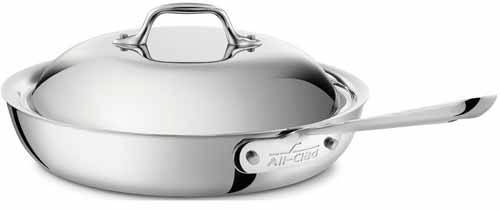
All-Clad 41117 11-Inch French Skillet with Domed Lid
The Stainless Collection is All-Clad’s most popular line of cookware, and with good reason. Showcasing a classic, elegant design and outstanding durability, it delivers the high level of performance professional chefs demand – and works just as well in the home kitchen.
Available in both an 11-inch version and a smaller 9-inch model, it is ideal for browning, searing, and pan frying a variety of ingredients, and it transfers from the stovetop to the oven or broiler with ease.
With a large surface area and tall, curved sidewalls, it excels at holding heat in the vessel and prevents splattering. And the sloped sides make tossing, shaking, and turning ingredients easy and efficient.
The large, domed lid sits in a niche below the flared lip for a very snug fit, which retains heat and locks in moisture – and allows for holding generous amounts of food in the pan.
The long, stay-cool handle and the loop handle on the lid are securely riveted in place, professionally crafted for a smooth interior surface so no food particles can get stuck.
Another All-Clad feature found on their stainless steel cookware is the starburst finishing pattern in the surface of the interior, which makes for excellent stick resistance. And the bottom of each skillet is engraved with a convenient capacity marking, so you’ll know exactly what size you’re working with if a particular recipe recommends a certain size pan.
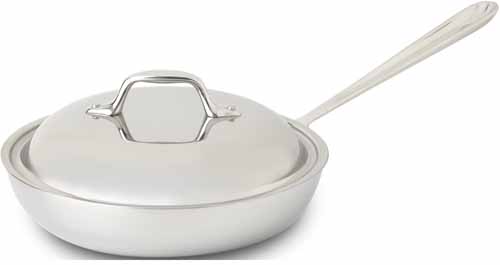
All-Clad 41096 9-Inch French Skillet with Domed Lid
With a core of aluminum enveloped in high-quality 18/10 stainless steel, the tri-ply metals offer superb heat conductivity and make it suitable for all stove types, including induction.
Dishwasher safe, although hand-washing is recommended. And Bar Keepers Friend is an excellent cleaner for keeping the mirror finish sparkling and shiny.
The 11-inch version of the French skillet, with its deeper walls and wider cooking surface, measures approximately 19 x 11 x 3.5 inches, and weighs 4 pounds. Made in the USA, it comes with All-Clad’s limited lifetime warranty to repair or replace products defective in material, construction, and workmanship.
What Others Are Saying
The following notes are compiled from the most frequent comments from verified purchasers on Amazon.
A large majority of the reviewers who have purchased this pan express a high level of enjoyment using it. It gets top marks for the function of its design, superior construction techniques, and easy cleanup.
This is a great piece for any kind of tossing and flipping as it has a nice heft and balance, and a good number of reviewers claim it’s light enough to handle without causing wrist strain.
The curved sides mean ingredients go back into the pan, not all over the stove, and the rounded edge where the walls and bottom meet makes it easier to get at food for stirring. Plus, the walls are higher than what you’ll find on traditional fry pans, so it can be loaded up with ingredients.
And it has all the hallmarks typical of All-Clad’s premium construction and quality control. The rivets securing the handles are sturdy with a smooth finish, the lid nestles into the lip for a perfect fit, and it heats evenly throughout the bottom and walls. This is a fully clad piece that transfers heat beautifully.
It also makes deglazing a fond effortless, and cleanup is easy as well.
A beautiful product with elegant lines, it adds a touch of class to any kitchen.
There are very few complaints about this pan. The only common threads are a couple of comments that food stuck to the surface, and another couple that said cleaning was a chore.
Summary
The All-Clad French skillet is a top performer that features a well thought out design with user-friendly details and a professional feel. With outstanding construction and quality control, it also has a beautiful appearance that’s second to none.
A pleasure to work with, it’s a valuable asset in the kitchen, and offers all the top qualities of stainless steel cookware.
And with a reasonable price tag for an elite performer, it receives top marks all around.
Check prices and read customer reviews on Amazon now.
Made In Five-Ply
Made In is a newer cookware manufacturer based in Austin, Texas. One of the few makers who have been brave enough to start producing in the USA, they offer 5-Ply Made-in-the-USA products at a price point just above the better made-in-China products. Or, about half that of All-Clad Tri-Ply.
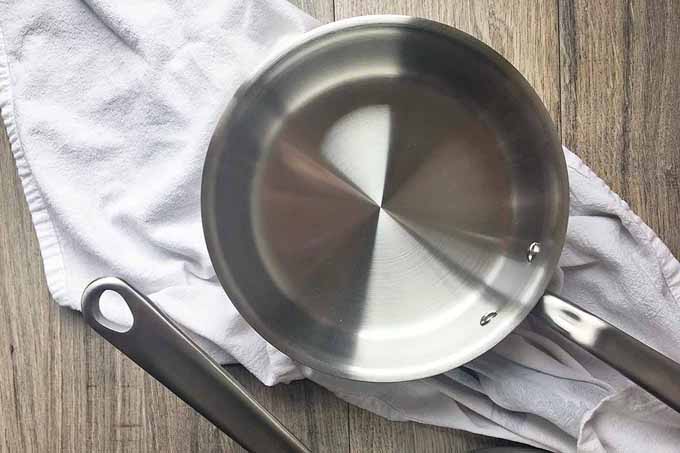
Their five-ply skillets are constructed with a top layer of nickel and chromium stainless steel, followed by a layer of aluminum for even heat dispersion, a layer of magnesium for strength, and another layer of aluminum, with a layer of magnetic stainless on the bottom, which allows it to be compatible with induction ranges.
The handles are made for comfort (unlike another higher end US manufacturer…) with rounded stainless forms designed to fit the hand.
10-Inch Frying Pan, available from Made In
We love supporting Made In, as they are committed to supporting the American worker, and the quality of their products is up there with All-Clad, without the high price.
See our complete review of their cookware or buy direct from Made In.
Tramontina Gourmet Prima Stainless Steel Tri-Ply
From Tramontina’s Gourmet Prima line, we have this attractive mirror finished stainless steel frying pan with a tri-ply base. This is a line of premium products, engineered and manufactured to deliver quality and value for the home enthusiast and professional alike.
Constructed of high quality 18/10 stainless steel, the base features an aluminum core that is impact-bonded for quick and even heat distribution. Aluminum is an ideal conductor of heat, and the magnetic stainless steel exterior makes it suitable for all stovetops, including induction.
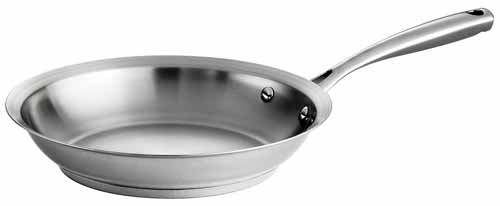
Tramontina Gourmet Prima 18/10 Stainless Steel Tri-Ply Base 12-Inch Fry Pan
It can be used with equal ease on the hob, in the oven, and even under the broiler.
The contemporary design features flowing lines with a flared lip for easy and dripless pouring, and curved walls for greater capacity.
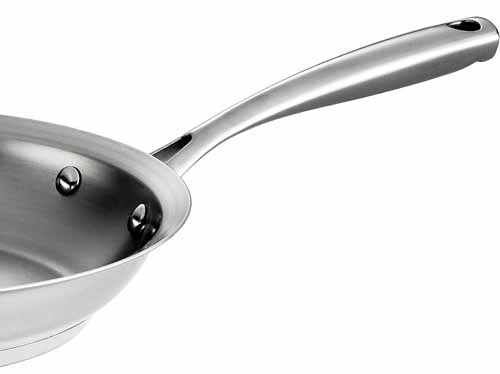
The long, ergonomic stay-cool handle is precision cast for a comfortable, secure grip, and it is securely riveted to the sidewall. And with a smooth, flush finish to the rivets, there’s no chance of collecting food particles where they shouldn’t be.
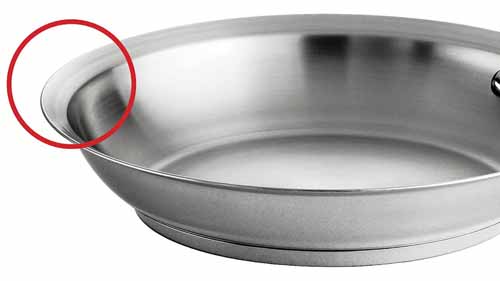
The flared lip means that pouring liquid from the pan is a breeze.
For best results, the tri-ply construction requires only low to medium heat to sauté, sear, cook, and fry most foods. Heating the pan too high can cause foods to stick, burn, or scorch.
To prevent buckling or warping, avoid extreme temperature changes such as those encountered when immersing a hot pan in a sink filled with cold water.
Cleanup is easy with warm soapy water, and the Prima can go in the dishwasher as well. Either way, hand dry promptly to retain the original finish. If discoloring or staining occurs, use a non-abrasive pad and a stainless steel cleaner such as Bar Keepers Friend to recondition.
The Prima fry pan measures approximately 21.5 x 13 x 2 inches, and weighs 3.5 pounds
Made in Brazil, it comes with Tramontina’s lifetime warranty.
What Others Are Saying
The following is a compilation of the most frequent comments from verified purchasers at Amazon.
A hefty majority of customers who have purchased the Tramontina Prima frying pan rank it very high for quality construction, even heat distribution, and top notch cooking properties.
It’s well-constructed and performs admirably on all stovetops, including induction.
The smart design means high functionality for all frying methods, and the flared lip makes pouring and serving easy.
Another favorite feature is that it cleans like a dream, regardless of what’s been cooked onto the surface. A short soak in soapy water cleans away most remnants, and a squirt of stainless steel cleaner keeps it shiny after repeated uses.
It provides excellent quality for the money, particularly if you find a fully clad pan to be too expensive.
There are a few commenters that claim it’s a bit on the heavy side, so the weight may be a bit much for those with weak hands or wrists – but this is a very personal distinction.
And on the complaints side, the only common issue is reported from those who have problems with foods sticking to the surface.
Summary
The Tramontina Prima fry pan offers high-end performance for a medium range price tag.

The well-constructed tri-ply disc bottom delivers exactly as it should – with quick and even heating that’s virtually free of hot spots. Thoughtfully designed with quality materials and workmanship, it offers great versatility, plus easy handling and cleaning.
This is a worthy investment for those who don’t want to go the more expensive fully-clad route for their cookware.
Check prices and read customer reviews on Amazon now.
Return to the Comparison Chart
Best Copper Skillets
Copper is an exceptional material for cooking.
In the periodic table of elements, it’s listed along with gold and silver in Group 11, the so-called coinage metals, due to their early function of providing value for trade in the form of coins.
Along with silver and gold, the three coin metals also rank only behind diamond in terms of thermal conductivity.
You’ll often hear that copper pots and pans conduct heat well – meaning they heat up quickly and transfer heat evenly to all surfaces. This is due to copper’s ability to transfer heat across surfaces more quickly than most other materials.
This fast rate of conductivity also puts copper at the top of the list in terms of being quick to respond to temperature changes – one of copper’s truly outstanding properties is how quickly the temperature of a pan will heat up, as well as cool down.
And this speedy thermal adjustment can be crucial to many fine aspects of cooking and baking. If you’ve ever watched a lovely sauce break down and separate right before your eyes while waiting for a cast iron pan to cool down, you’ll appreciate the significance of this feature!
Plus, this ability to heat and cool quickly also makes copper one of the most energy efficient of materials – a feature that offers some savings over the course of a pan’s lifetime.
The superb, even heating comes from the unhindered transfer of thermal energy, which is equally distributed throughout the bottom and walls of a pan. And again pans without hot and cool spots, which are caused by uneven heating, are more energy efficient as they require less total cooking time.
This even heat distribution also means less chance of ingredients sticking, which makes cooking with copper a real treat.
And if you’re looking for cookware that offers value, with just a little TLC, copper will last for generations, adding memories and family heritage to its provenance.
But of course, copper is not without its drawbacks.
Unlined, copper has the tendency toward unwanted chemical reactions with a variety of foods, particularly acidic items like citrus and vinegar, as well as dairy.
Tin is still widely used today as a copper liner, and is probably the oldest known material used for this purpose. Tin proves to be a good choice as it also has outstanding conductive properties, which won’t impede or obstruct copper’s favorable qualities.
Plus, tin is also relatively inexpensive to produce and manufacture. However, if used on a regular basis, it will wear out over time, requiring the pan to be re-tinned. And this can mean being without your favorite pan when you wish you could be using it…
Stainless steel is another popular lining, thanks to its stain-resistant properties, and overall strength and durability. But stainless steel doesn’t have the same conductive properties as tin, which makes it a bit more prone to sticking than either bare or tin-lined copper.
And, of course, copper oxidizes quickly, even when it’s just hanging from a rack in the kitchen. Frequent cleaning is required to keep copper pans looking good, whether they’re being used or not.
Many will allow an exterior patina to build up between polishing sessions, while others like the bright, shiny appearance of a pan that’s been polished with every wash-up. Check out our post on how to care for copper cookware for detailed instructions on cleaning and polishing your favorite pieces.
Another drawback is that copper is not a suitable metal for use on induction stovetops. In order to use copper cookware on induction ranges, an additional magnetic plate is required. Or, you can look for copper pans constructed with a bottom constructed of magnetic material – though there are surprisingly few currently available.
Last but not least, there’s the cost issue as well.
Given copper’s outstanding properties and overall value (it is ranked with gold and silver in the periodic table, after all), the durability and longevity of a pan made from this metal, and naturally, its mesmerizing appearance, the cost is understandable. I haven’t purchased any skillets made of silver or gold recently, but I’m guessing they’d be pretty pricey too…
Properties to Ponder When Considering Copper
For the best value, the following features should be given some attention and thought before making a purchase:
Thickness
The best value and performance comes from copper pans with a thickness of 2 millimeters or more, with 2.5 millimeters being the ideal.
Handles
Handles are often made of different materials, depending on the thickness of the copper used. Those with a heavy 2.5-millimeter thickness will usually have cast iron handles. Thicknesses of 1.5 and 2 millimeters will usually have brass or bronze, and stainless steel handles respectively.
Regardless of the materials used for the handles, look for ones that are securely riveted to the pan walls.
Linings
Tin is still a popular liner with its quick conductivity and nonstick properties. Stainless steel is popular as well, thanks to its stain resistance and durability.
Weight
Copper is a heavy material, and a pan’s weight should be given some consideration – particularly if you plan to do a lot of tossing or flipping with it.
Cleaning
You have to be honest with yourself on this one: Do you really have the time, energy, and inclination to polish your pans on a regular basis? Or can you train yourself to see a certain bohemian beauty in the natural patina, and let the polishing slide?
Whatever your choice, copper is a little high maintenance if you want to maintain that shiny appearance. See Foodal’s Guide to Cleaning Copper Cookware for more details on keeping yours pristine.
There’s no question that copper is an outstanding material for pots, pans, and skillets – it has a number of superb qualities that put it in a league of its own.
Mauviel M’Heritage Copper Frying Pan with Cast Iron Handle
From Mauviel, the well-known French producers of beautiful copper cookware, we have the M250C. From their M’Heritage line, this is a gorgeous 10.5-inch copper frying pan with a stainless steel lining and cast iron handle.
With sloped sides for high-heat frying, the M250C features an extra thick copper layer measuring 2.5 millimeters, which meets professional standards. It heats more evenly and much faster than other metals, and provides superb temperature control as well.

Mauviel M’Heritage Copper M250C 10.5-Inch Round Frying Pan
Bi-laminated at a ratio of 90% copper to 10% stainless steel, the M’Heritage M250C is made with just enough tough stainless to line the pan without inhibiting its thermal functions. The 18/10 stainless steel interior is non-reactive, will hold up to a lifetime of heavy use, and never needs to be resurfaced. And it has all of the stain resistant and easy-to-clean properties that we love about stainless steel.
The sturdy copper pan has an equally durable handle of cast iron, which is securely attached to the pan’s side wall with stainless steel rivets, and can go directly from the hob into the oven.
The Mauviel M’Heritage can be used on any stovetop. But for use on an induction range, an induction stovetop interface disc will be needed, as copper doesn’t have the required magnetism on its own.
The M’Heritage M250C measures approximately 20.5 x 11.5 x 4 inches and weighs 7 pounds. Made in France, it comes with Mauviel’s lifetime guarantee against manufacturing defects.
Hand washing is recommended, cleaning the interior as you would stainless steel. For the exterior, clean with salt and white vinegar and scrub with a sponge. Or, Mauviel makes their own popular copper cleaning paste, and a product like Bar Keepers Friend Cleanser and Polish will do nicely as well.
What Others Are Saying
The following remarks are taken from the most often repeated comments from verified purchasers on Amazon.
The Mauviel M’Heritage M250C Frying Pan gets top marks for superb heat control, outstanding construction and material quality, and for being flat-out stunning to look at.
Several reviewers comment about how responsive the M250C is to temperature changes. It heats up and cools down quickly, and responds to even minor heat variations on the burner.
A few purchasers have also made the recommendation that if you’re new to copper, turn the heat down to medium-low until you get a feel for just how fast its response time is.
The high-quality components also get their share of compliments. From the robust, thick copper and delicately brushed stainless steel to the flawless glaze on the cast iron handle, these pans are skillfully made, and meant to last for generations.
Plus, the stainless steel lining offers the Goldilocks ideal – thin enough to maintain the thermal reactivity of the copper for perfect heat distribution, but thick enough to ensure it will last with repeated use.
The pan itself cooks like a dream, with special appreciation noted by those who use it for searing, deglazing, and frying delicate eggs – everything cooks well in this pan, including a flambé.
And while there are no common themes on the complaints side of the ledger, a remark worth repeating references the weight of the cast iron handle – in a nutshell, it’s heavy. A couple of reviewers said they didn’t have a problem with the handle’s weight, but pointed out that their slighter-built partners did.
Summary
The Mauviel M’Heritage copper frying pan is truly a functional piece of art.
With the gleaming copper, shiny stainless steel, and stout cast iron, it’s beautiful to behold. The skilled artisans who crafted this pan did so with the intention of creating an effective tool that will serve its owners for decades.
Superbly crafted of heavy-duty components, this is a hefty pan with outstanding heat reactivity and even heating for the skilled chef and novice alike– and its beautiful presentation is delightful as well.
And for a copper pan of such outstanding character, the Mauviel M’Heritage M250C offers great value in terms of price, along with its beauty and performance.
Check prices and read customer reviews on Amazon now.
DeBuyer Prima Matera Copper Frypan
From another well-established French producer of copper cookware, the DeBuyer Group, this dazzling 11-inch frying pan is from their Prima Matera line of copper induction cookware. That’s right, this is a copper pan that can be used with induction, without any additional add-on products required.
Among cookware options, copper is the best heat conductor – one that ensures a perfectly even heating circuit throughout the entire surface area, including the walls. And the Prima Matera’s 2-millimeter-thick layer of copper is up to the task.
DeBuyer Induction Capable Copper Prima Matera 11-Inch Fry Pan
Prima Matera pans are comprised of a bi-laminate and the interior material is made of 90% copper and 10% stainless steel. And because of the special magnetic iron and stainless steel bottom, it provides exceptional cooking performance on any range – including induction.
The long, ergonomic handle is made of cast stainless steel that has been cold-riveted to the side wall, adding an elegant and fluid line to the pan’s Lyonnaise profile – shown in the high, curved walls with no sharp angles to ensure food slides easily in the interior, and onto a plate or serving dish.
The stainless steel interior is made from food grade 18/10 steel. It’s tough and durable, but doesn’t impede the conductivity of the copper – and this makes it easy to clean.
With a polished mirror finish, each piece in this unique line has an identification code engraved on the base for authenticity.
Hand washing is recommended for the stainless steel, and a polishing paste is recommended to care for the copper.
The 11-inch version of the Prima Matera pan measures approximately 4.5 x 11 x 2 inches and weighs 3.5 pounds. Made in France, it comes with DeBuyer’s lifetime warranty against manufacturing defects.
It’s also available in a smaller 9.4-inch version.
What Others Are Saying
With only one review on Amazon.com at the time of this writing, we’re not going to dish on what verified purchasers think of this pan… But, we do have an in-house review of DeBuyer’s Prima Matera line for copper induction cookware – which gets a big thumbs up from us.
Summary
DeBuyer is one of the few manufacturers to produce a line of copper cookware suitable for induction stovetops. And this Prima Matera fry pan isn’t simply a tri-ply with a thin veneer on the exterior – the copper layer is 2 millimeters thick, and it displays all of the outstanding characteristics that make us love this exceptional metal.
The ferromagnetic bottom is applied after the copper is stamped, then finished by hand to create a pan that responds with copper’s classic quickness on all stovetops, even induction. And the cast stainless steel handle is not only dramatically handsome, it makes maneuvering the pan a pleasure as it adds little to the overall weight.
With a price tag well north of the majority of products on the market, the DeBuyer copper fry pan won’t be on everyone’s shopping list – it is expensive. But if you’re in the market for a top-of-the-line copper pan that’s ready, as is, for use on an induction stove, it would be hard to beat this Prima Matera beauty from DeBuyer.
Return to the Comparison Chart
Best Nonstick Skillets
The best nonstick frying pans have several properties that are useful on the range:
The most obvious is their food-release qualities, which prevent ingredients from sticking. And, as foods won’t stick or burn easily, this also makes for quick and easy cleaning. A wipe with a soft cloth or sponge in warm, soapy water will usually do the trick.
Another benefit is that they don’t require as much fat or oil for frying tasks, which makes for healthier, leaner, low-fat cooking.
And as they’re often constructed of aluminum, the weight can be considerably less than that of cookware made with heavier metals, which makes them easy to handle and maneuver – a definite bonus for those with weakness in the hands or wrists.
All of these attributes make them ideal for cooking delicate items such as crepes, omelets, eggs, pancakes, and fish. And they do a good job of other tasks as well, such as sautéing and braising.
But, like the other materials above, they do have their drawbacks.
These chemical coatings need to be treated gently. Using abrasive sponges, scouring pads, or steel wool for cleaning (or metal utensils for cooking) results in scratching, chipping, and flaking – and after that’s it’s bye-bye nonstick coating.
Traditional nonstick gets its slippery surface from a coating of polytetrafluoroethylene (PTFE), a synthetic fluoropolymer with the most common brand name being Teflon.
Part of the manufacturing process for PTFE uses a chemical known as perfluorooctanoic acid (PFOA), which has been linked to numerous health and environmental issues.
PFOA is what the EPA deemed an “emerging contaminant,” due to its extremely persistent toxic nature in the environment, and when airborne, its ability to travel long distances.
This “cause for concern for the environment and human health” is what led the EPA to create a voluntary pact with manufacturers who use PTFE. The goal was to eliminate PFOAs from the manufacturing process entirely by 2015.
In a nutshell, ingesting PFOAs in the bits of coating that flake off, inhaling the fumes, and discarding nonstick items in landfills are not healthy for us, or our lovely planet.
Due to this voluntary ban on PFOA, manufacturers have come up with some innovations for PFOA-free nonstick coatings, such as ceramics and diamond particles. While claims abound that these new products are much tougher than traditional nonstick surfaces, durability and longevity issues still remain.
Regardless of the coating used, nonstick surfaces are still subject to scratching when metal utensils are used, and many lose their nonstick properties within a short timeframe.
Also, many nonstick pans have an upper temperature limit. Heating beyond this limit will often result in a breakdown of the coating, leaving them pretty much useless… and potentially toxic.
This leads to another irksome point with many cooks: their limited ability to sear and brown.
Because of the temperature limitations of this material, browning and searing are difficult to achieve – often, a piece of meat will simply stew in its own juices. It’s best to use cast iron, carbon, or stainless steel for these tasks.
Don’t forget: if you have a nonstick set, you’ll need a buffer of some sort if you are stacking them, to protect the surface. Use an old tea towel to provide a protective layer in between.
Helpful Features to Look For:
PFOA-Gree
While many manufacturers still use PTFE to create their nonstick surfaces, ensure that your purchases are free of PFOA, because of ongoing health and environmental issues.
Oven-Safe Handles
Handles of stainless steel or silicone can usually go in the oven just like silicone baking mats, whereas those made of plastic can’t – but do check temperature restrictions either way.
Rivets
Look for handles that are riveted onto the body, as screws and bolts have a tendency to come loose with regular use.
Induction Compatible
If you use an induction stovetop, check to see if the one you’re considering is compatible. Many will have a stainless steel disc bonded to the bottom for use with induction stoves – but you want it to be the same size as the pan, not smaller in diameter.
Warranty
Due to the inherent problems with nonstick pans, a credible dealer and no-hassle warranty helps to alleviate any frustration when they fail.
Woll Diamond Plus/Diamond Lite Induction Nonstick Fry Pan
From Woll, we have one of the newer technologies in nonstick cookware that uses a diamond reinforced surface, the aptly named Diamond Lite Nonstick Fry Pan.
Woll’s patent pending procedure blasts superheated diamond crystals deep into the surface with a plasma gun, creating an exceptionally hard base.
After an anti-corrosive layer and a primer are added, a final top coat is infused with more diamond crystals, then baked on. This produces a durable, abrasion-resistant nonstick coating with no blisters, bubbles, or peeling, and it is also PFOA free.
The diamonds are a super-conductor of heat as well, four times as fast as copper. The superb and even heat distribution means no hot spots, and makes it ideal for browning, searing, frying, and deglazing.
Woll Diamond Plus/Diamond Lite Induction 12.5-Inch Fry Pan with Lid
The aluminum alloy is gravity cast, meaning it won’t warp or crack if shocked with extreme temperature changes – such as plunging a hot pan into cold water.
The long, ergonomic handle makes for comfortable lifting, and is securely attached with a threaded brass insert for strength and stability.
Oven safe to 500°F, the Diamond Plus is also safe for use with metal utensils, and can go in the dishwasher.
Besides the 12.5-inch model pictured above, this line is also available in 11-inch and 9.5-inch models.
Made in Germany, these pans come with Woll’s limited lifetime warranty, which covers manufacturer’s defects but not user damage such as misuse or abuse, overheating, or scratches. And the coating itself has a three-year warranty.
And as long as you purchase a “Plus” or an “Induction” model, be assured that your pan will be compatible with induction hobs.
A note on terminology: It appears that Woll is rebranding this line from “Diamond” to “Diamond Lite.” The “Plus” portion used to signify that it was compatible with induction but that has more recently been replaced, well, with the word “Induction.” So you may see a mix of these names and phrases from various retailers.
If you don’t need induction compatibility, feel free to avail yourself of any of the options offered in the Woll Diamond or Woll Diamond Lite lines. However, if you have induction or plan to get an induction range in the future, you’ll want to look for the Woll Diamond Lite Induction series. The cost difference for the induction compatible models is minimal, so we suggest this as the best bet for most people.
What Others Are Saying
The following is a compilation of the most common notes from verified purchasers at Amazon.com.
Happy shoppers rate this one high in the areas of durability, quality construction, and easy food release.
Several have reported that it heats quickly and evenly with no hot spots, and suggest using low to medium heat for the best performance – and that foods simply won’t stick when higher temperatures are avoided.
Another selling point is the high quality of construction, with a nice balance and heft, making it the go-to pan for a wide variety of cooking jobs.
It’s also very easy to clean with just warm, soapy water and a cloth, or you can pop it in the dishwasher.
And, you don’t have to buy wooden or silicone utensils to use with the Diamond Plus, as metal utensils won’t damage it. The surface is tough and durable, with no flaking.
While there aren’t a lot of complaints, the most common is that the nonstick properties of the pan have failed after a period ranging from a few months to a few years of regular use.
Some have also complained about scratches on the surface, similar to what occurs commonly with other nonstick-coated materials.
Summary
An innovative change from traditional Teflon-style surfaces, the Diamond Plus is becoming a favorite among those who enjoy using nonstick.
It has a generous cooking area that heats quickly and evenly, and excellent food release qualities – and a pretty, sparkly look!
And although the nonstick coating isn’t perfect, it rates much higher in consumer confidence than most of Woll’s competitors in the nonstick market.
A bit pricey compared to traditional nonstick cookware, the pan does come with a diamond coating – and satisfied customers feel it’s worth every penny.
Check prices and read customers reviews on Amazon now.
T-fal Professional Total Nonstick Fry Pan
T-fal is one of the most recognizable names in nonstick cookware, and their Professional Total Nonstick Fry Pan is a perennial favorite among online shoppers.
The interior surface of the Professional line is treated with four layers of Prometal Pro, an extremely durable and scratch-resistant coating that’s free of PFOA, lead, and cadmium – and it’s suitable even for use with metal utensils.
T-fal E93808 Professional Nonstick 12-Inch Fry Pan
The body is constructed of heavy-gauge aluminum for fast and even heat distribution, and is fitted with a full-sized stainless steel disc bottom. This makes it suitable for all stovetops, including induction.
One of T-fal’s unique features is the Thermo-spot heat indicator in the center of the pan. When preheated to the ideal temperature, the spot pattern disappears and is replaced with a solid red color, to indicate when it’s hot enough to begin cooking.
Constructed with a slight convex hump at the center, excess fat and oil will drain to the edges, for cleaner and leaner cooking. And this bump will not adversely affect heat distribution or cooking performance.
The silicone handle is designed for a comfortable grip, and is attached to the body with sturdy soft-touch rivets for stability. It’s also oven safe to 350°F.
Besides the 12-inch model pictured above, T-fal also offers this pan in 10.25-inch and 8-inch models.
When you first receive your Professional pan, T-fal recommends a quick treatment to further enhance its nonstick properties. Wash and dry, warm on low heat, and rub in a light coating of oil before using.
For best results, use on medium or low heat, and do not allow liquids to boil dry.
The nonstick surface makes it easy to clean with warm, soapy water and a sponge, and it can go in the dishwasher as well.
Made in China, it comes with T-fal’s limited lifetime warranty, which guarantees the pan to be free of manufacturing defects but does not cover accidental damage, overheating, misuse, commercial use, staining, discoloration, or scratching of nonstick surfaces.
What Others Are Saying
The following notes are a compilation of the most frequent remarks from verified purchasers on Amazon.com.
A very popular pan in the nonstick niche, the Professional gets top grades for its superb nonstick performance, ultra-easy cleaning, and versatility.
By far the most favorable component is the nonstick surface, which not only releases food with ease, but also has a level of longevity rarely found with coated surfaces – with little or no signs of wear after a few years of regular use. Even those with complaints in other areas praised its stick-resistant qualities.
And for those who like low-fat frying, it’s a great option. A little oil is adequate for most jobs, and the slightly convex center drains away excess fat for leaner cooking.
Suitable for most frying tasks, it produces excellent results for foods like pancakes, crepes, eggs, bacon, and steak.
A common note among those who rate it highly is to follow the instructions to apply a light seasoning before using.
Another highlight of the stick-free surface is that it makes cleaning easy with just a dry wipe with a paper towel, or a swish in soapy water.
The heat distribution is even and consistent as well, and the silicone handle is comfortable and holds up well to repeated use.
However, it’s not without its detractors. The most common complaint is that the convex hump in the center is annoying, and causes liquids and eggs to slide to the edges. This seems to be the most common with the 12-inch model.
Some also note that the hump “grows” when the pan is heated, while others report warping on the bottom.
And there are also a few comments noting that it doesn’t perform all that well on convection hobs, with higher settings than “normal” required to thoroughly heat.
Summary
The T-fal Professional Total is undoubtedly a favorite of the nonstick crowd, with one of the best stick-resistant surfaces available. The surface, and the pan itself, also prove to be durable – particularly when the care and maintenance instructions are followed carefully.
But, if you’re looking for a pan with a perfectly flat interior surface, this won’t be suitable for your needs. While a large majority of users feel the center bump isn’t an issue, those who don’t like it find it to be mighty irksome.
Still, for the economical price tag, it’s a very reliable performer that gives consistent results.
Check prices and read customer reviews on Amazon now.
Return to the Comparison Chart
Concluding Thoughts
Obviously, when shopping for fry pans and skillets, your personal preference is the most important factor.
All of the materials listed – cast iron, carbon steel, stainless steel, copper and nonstick – have their individual pros and cons. If you find that a single pan alone won’t suit all of your needs, then you might want to consider a combination of options to suit your cooking style.
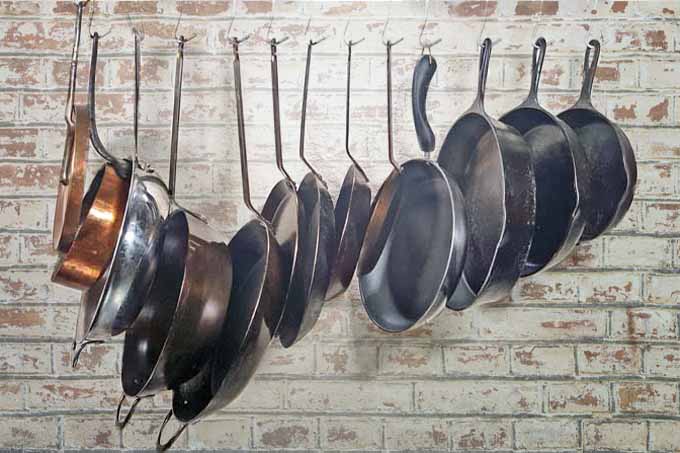
But regardless of what you’re looking for, hopefully we’ve narrowed down the selection criteria for you to make the most informed decision.
And if you already have a frying pan or skillet that you adore, let us know your recommendations in the comments below – your fellow foodies always appreciate a few new insights!
Photos by Nikki Cervone and Mike Quinn, © Ask the Experts, LLC. ALL RIGHTS RESERVED. See our TOS for more details. Product photos via Lodge, Cuisinart, DeBuyer, Demeyere, All-Clad, Made In, Tramontina, Mauviel, Woll, and T-fal. Uncredited photos: Shutterstock.
About Lorna Kring
Recently retired as a costume specialist in the TV and film industry, Lorna now enjoys blogging on contemporary lifestyle themes. A bit daft about the garden, she’s particularly obsessed with organic tomatoes and herbs, and delights in breaking bread with family and friends.


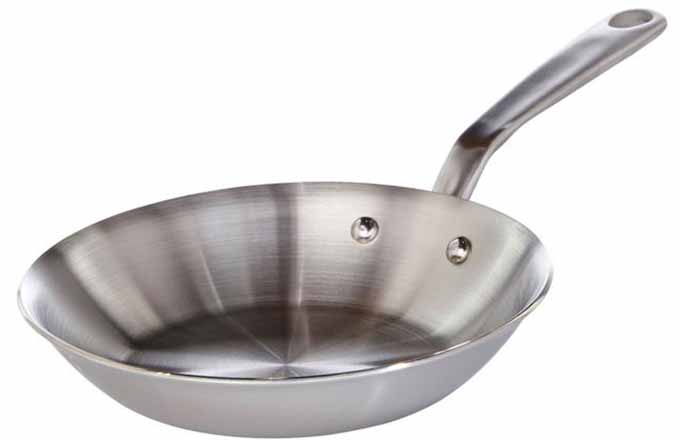

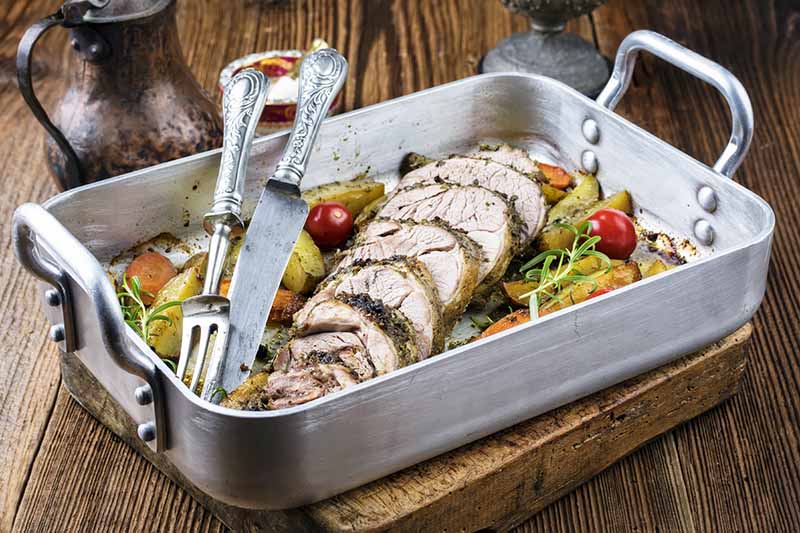

I really enjoyed this post….very informative. Personally, I absolutely love cooking with cast iron, but if I wanted to try something different, I would probably go with the carbon steel. I didn’t know anything about it before reading your post, but it seems the most like cast iron–but just a little lighter.
I’m with you on the cast iron atlmom5! And you’re right, the carbon steel quite a bit like a light version of CI. My favorite wok is carbon, and the lightness is great for tossing and flipping.
At this point of the post, I’m not afraid to say that I don’t know anything about frying pans, literally anything.
But this one was definitely informative, especially for people like me, lol. Because at one point in my life I am going to need one and this was definitely a really good introduction for that. And also, it’s really interesting how “small” factors (such as weight! I haven’t think about that!) can make such a big difference.
Thanks for sharing! 🙂
Thanks ae, hope you got some good ideas!
Oh my gosh! I feel like such a fool! I came to this article to see what sort of frying pan I should get because of how terribly our cast iron skillet has been cooking. Everything stuck to it! Our fried egg sandwiches turned into scrambled egg disasters! Now I know that it just needs to be seasoned properly! Saved me a bit of cash here! Going to give that a try, wish me the best!
Edit: Ah! You even have a whole article on that specifically! Perfect!
Awesome deanyd, always glad to hear we’ve saved someone a few coins! And have fun with the seasoning process.
That was a lot more information than I thought would be presented for an article about pans! I know the topic is important and people to often just buy a cheap skillet from Walmart but wow, I am amazed with the amount of useful information provided. Thanks for all the hard work. That being said I am a cast iron guy myself. My girlfriend bought me my first nice pan a few years ago and I never looked back to using the cheap stuff since. I have sent this article to my dad as he is really big into cooking and I am sure he will be a subscriber as soon as he finishes reading this post. Thanks again for all the hard work!
You’re welcome ad.mike! So glad you found the post informative…
This article has been so helpful in my search for a new set of pots and pans! I’ve always used nonstick but wanted to try something different this time around, as none of my pans usually last long. Chipping, warping, nonstick surface just disappearing… Now I’m feeling as though it’s been mostly my own doing! Apparently I haven’t been treating them right. I’ve learned so much! Maybe I’m finally ready for some big-girl stainless steel. Even if I go the nonstick route again, I feel absolutely sure they’ll last longer now that I know how to take care of them better. Thank you for this article! 🙂
You’re so welcome, Ashley! Happy cooking!
Thanks a lot for such a well researched article, it saved me a lot of money and time. Great work!
Glad to help Lucia!
Regarding the pan listed below, some reviews from Amazon noted that the handle is coated with an epoxy that cannot go into a hot oven. Others noted that removing the beeswax was very difficult with unsatisfactory results.
De Buyer
MINERAL B Round Carbon Steel Fry Pan 12.5-Inch
Amazon review
“I had planned to oven season the pan. I was disappointed to discover that this pan came with an epoxy coated handle which limits is use in ovens which prevents me from seasoning the pan in an oven the way I had planned, without risking damage to the epoxy coated handle.”
From De Buyer: (This is a quote from from de Buyer’s own FAQ.)
“Are iron cooking utensils suitable for traditional ovens?
All cooking utensils from our iron ranges can be used in traditional ovens. Nevertheless, pans equipped with an iron handle coated with epoxy can only flash in the oven (10 minutes at 200°C maximum) as an extended exposure to heat or to a higher temperature might damage the epoxy coating.
Thanks Wendy, appreciate the info.
What is your opinion on the AMT Gastroguss range of pans?
I purchased the Woll frying pans and they are garbage. Within 4 months they bubbled and peeled. They cooked great to start, but then started to bubble and peel. The company does not honor their warranty claiming if you cooked bacon in it then you misused it. Why am I buying a 12″ frying pan of not to fry with it…. You guys really need to do some more homework and you lost your credibility with this consumer for recommending such an expensive product that is worthless… Wasted over $250.00 on pans that are now worthless and they are only 4 months old…
When you decide which type you’ll need, you should let a number of different elements weigh in as the basis for this purchase. The two most important factors come down to the type of food you’ll be serving and the number of guests you plan to serve throughout the day.
This article was exactly what I needed and I’m so thankful that you did all this research! My family is eliminating all the plastics and chemicals from food containers and non-stick coatings (goodbye, Teflon) for health reasons and my mother turned to ceramic coated cookware. I wondered if there was a better option. I already have some stainless steel skillets, but not frying pans. I suspect your article was written before this trend in ceramic coatings began. Any thoughts on ceramic coated frying pans? Otherwise it seems you need one iron (or carbon) for browning/searing and one copper for things that require more temperature control. Oh, rats… time to go shopping! 🙂
Very useful article with in-depth discussion of important product attributes, appropriate uses, pros & cons. I am looking to replace my Circulon 12″ non-stick fry pan that has now warped beyond tolerance after about 10 years of regular use (I have a ceramic smooth top cooking range). I’ll say this – the Circulon non-stick surface has held up amazingly well over its life. I would have liked inclusion of additional manufacturer’s “non-stick” frying pans, (e.g., Circulon) in your reviews, but I’m quibbling a bit here. Lots of relevant information I was previously unaware of – such as the inherent unsuitability of non-stick pans for searing and browning. Thank you for researching & publishing.
FWIW, I just ordered the 12″ Tramontina gourmet Prima pan with tri-ply base…wish me luck!
Very informative and enjoyable post. Thank you for your nice article.
Thanks for showing the best frying pans….. I needed to buy a frying pan for egg cooking and I landed your website to read reviews here.
Whenever T-Fal makes anyone’s “best” list, in any category, they lose all credibility. T-Fal is the worst, unhealthiest, cheapest cookware that has been replaced the most often. All this article did was gather a few names of cookware and give little blurbs about them. Nothing helpful whatsoever. But, hey, that gave you ample opportunity to put a bunch of Amazon links in the article for you to make some money off of.
And THAT is all this article was clearly written to do.
Hi Jack. We’ve tested all of those pans in that list. The opening photo? I took that from my kitchen at the time.
Bluntly. Non-stick cookware should be treated as a perishable product – at any price point. Buy products with a decently thick layer of aluminum (whether it be solid or multiply) and be prepared to junk them in 3-4 years. None of them will last.
T-Fal fits that price to performance ratio perfectly. Decently thick to help spread heat and moderately priced. No, you won’t be handing them down to your grandchildren.
Yes, we make a little money off of these guides (as stated at the very top). You wanna know what else we do? We provide 2000 free recipes, most with step-by-step directions. All with minimally intrusive ads when compared with almost all other recipe sites.
Oh, and what else? We employee dozens of US recipe creators, gastronomists, and registered dietitians, and on our gardening site, master gardeners and plant pathologists. Most of whom work at home – giving them a chance to have a better quality of life, take care of children or parents, and in a post-covid world, practice social distancing.
God forbid that we should actually bring in a bit of income while assisting people through well-researched and tested product recommendations and ad placements to pay all of these people and contribute to the economy. What’s in your wallet?
Nice response Mike ! I thought it was a measured, fair and informative piece of advice. Thank you and you deserve to keep earning a few dollars with your reviews and endorsements.????
A ton of information about frying pans. Just awesome!
Thanks for the time, effort, and work required to write this article. I appreciate the information. We’re looking to purchase a 12″ fry pan and your info will help us get the best value for our money.
I mean putting lodge products in half these categories is rough …. But other than that it was a solid read
I love this article so much I am downloading a copy for all-time reference.
My problem still is I have always wanted a carbon steel for its searing properties, but do not have strong arms to carry them around. May be I can only appreciate them from far, and stay content with my non-stick 🙁 Sad.
Thanks for your message, Kay! One benefit of certain carbon steel pans is that they include two handles – having a long “frying pan style” handle on one side, and a smaller “helper” handle on the other can make them easier to carry and move when they’re on the stove.